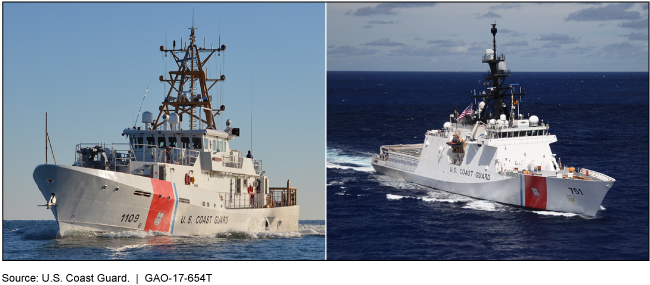Coast Guard Recapitalization: Matching Needs and Resources Continue to Strain Acquisition Efforts
Fast Facts
The Coast Guard is a decade into its effort to modernize its fleet, and many new ships and aircraft are now in service.
For example, the Fast Response Cutter and National Security Cutter offer greater endurance and effectiveness than the ships they replaced—though maintenance and equipment issues have limited their operations.
More broadly, the affordability of the Coast Guard’s portfolio is in doubt, and its new Offshore Patrol Cutter will strain funding for other programs. Although we are not making recommendations in this testimony, we have made recommendations in recent years to help the Coast Guard plan for future acquisitions.
The Coast Guard’s Fast Response Cutter and National Security Cutter

Photos of the Coast Guard's Fast Response Cutter (left) and National Security Cutter (right)
Highlights
What GAO Found
The Coast Guard is currently procuring three new cutter classes that are intended to have more capability than the legacy assets they are replacing. In particular, the National Security Cutter (NSC) and the Fast Response Cutter (FRC) are generally demonstrating improved mission performance (see figure). Both cutters have greater fuel capacity and efficiency and handling/sea-keeping than the legacy assets they replace, all of which increase endurance and effectiveness. Another new asset—the Offshore Patrol Cutter (OPC)—is also expected to provide increased capabilities compared to the Medium Endurance Cutter it is replacing, such as the ability to conduct longer patrols.
The Coast Guard's Fast Response Cutter and National Security Cutter

The Coast Guard, however, has not been able to take full advantage of the FRC's and NSC's capabilities because of maintenance and equipment issues limiting their time available for operations. GAO found in March 2017 that while both cutters met their minimum mission capable targets on average over the long-term, more recently—from October 2015 to September 2016—they fell below their minimum targets due to needed increased depot-level maintenance. Both cutters have also been plagued by problems with critical equipment, such as the diesel engines, which have contributed to lost operational days.
In June 2014, GAO found gaps between the funding amounts the Coast Guard estimates its major acquisitions need and what it has requested. This has continued. For example, senior Coast Guard officials peg acquisition needs at over $2 billion per year, but the President's budget requested $1.2 billion for fiscal year 2018. In an effort to address funding constraints, the Coast Guard delayed new acquisitions through the annual budget process, but lacks a long-term plan to set forth affordable priorities. As a result of these issues, it is facing a gap in the capability provided by its Medium Endurance Cutters, which are slated to reach the end of their service lives before all the OPCs are operational. GAO recommended in 2014 that the Coast Guard develop a 20-year fleet modernization plan that identifies all acquisitions needed to maintain the current level of service—aviation and surface—and the fiscal resources needed to buy the identified assets. DHS concurred with the recommendation, but it is unclear when the Coast Guard will complete this effort.
Why GAO Did This Study
In order to meet its missions of maritime safety, security, and environmental stewardship, the Coast Guard, a component within the Department of Homeland Security (DHS), employs a variety of surface and air assets, several of which are approaching the end of their intended service lives. As part of its efforts to modernize its surface and air assets (an effort known as recapitalization), the Coast Guard has begun acquiring new vessels, such as the National Security Cutter, Fast Response Cutter, and a number of air assets, and developing the Offshore Patrol Cutter. Despite the addition of new assets, concerns surrounding capability and affordability gaps remain.
This statement addresses (1) the capabilities provided by the newer Coast Guard assets, (2) maintainability and equipment challenges for the new cutters, and (3) the overall affordability of the Coast Guard's acquisition portfolio. This statement is based on GAO's extensive body of work examining the Coast Guard's acquisition efforts spanning several years, including the March 2017 report on the NSC and FRC's maintainability.
Recommendations
GAO is not making recommendations in this statement but has made recommendations to the Coast Guard and DHS in the past regarding recapitalization and the specific assets involved, including that the Coast Guard develop a 20-year fleet modernization plan that identifies all acquisitions needed to maintain the current level of service and the fiscal resources needed to acquire them. DHS agreed with this recommendation.
